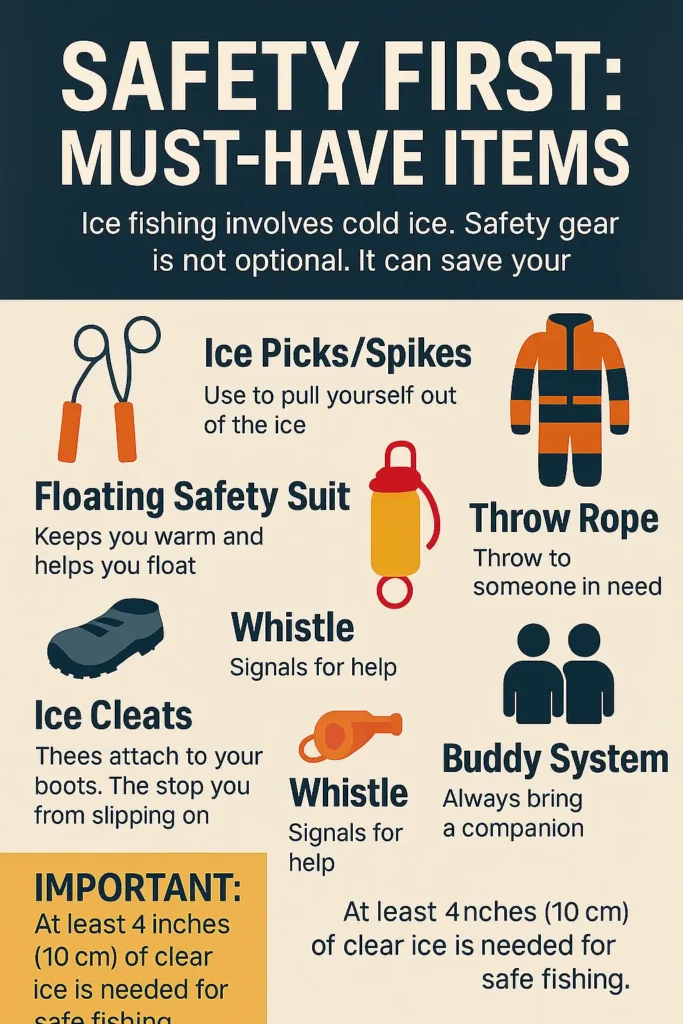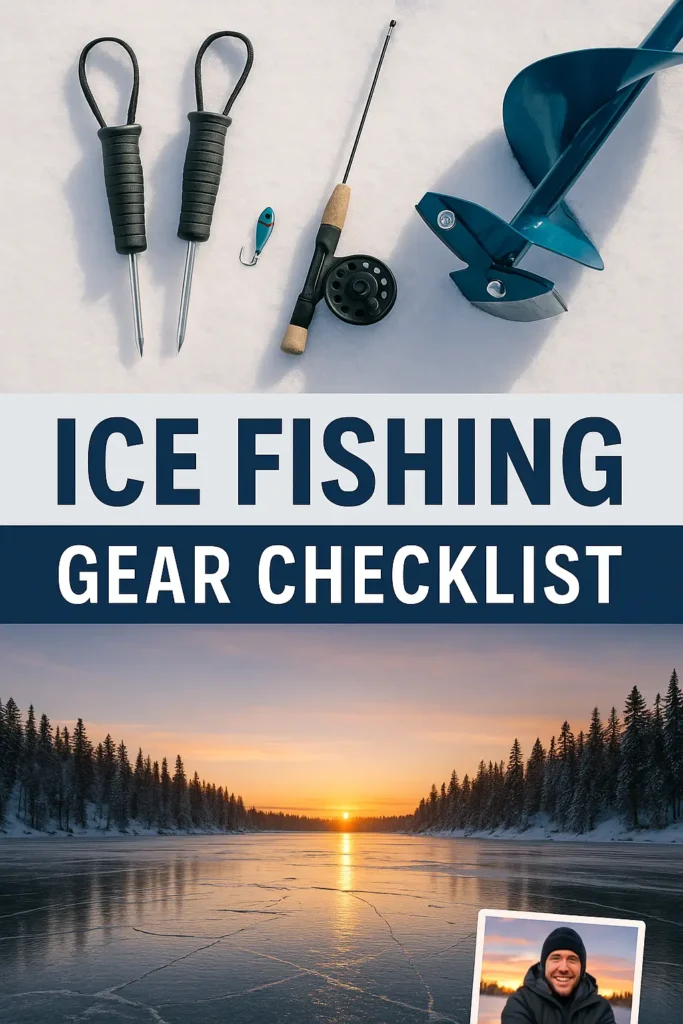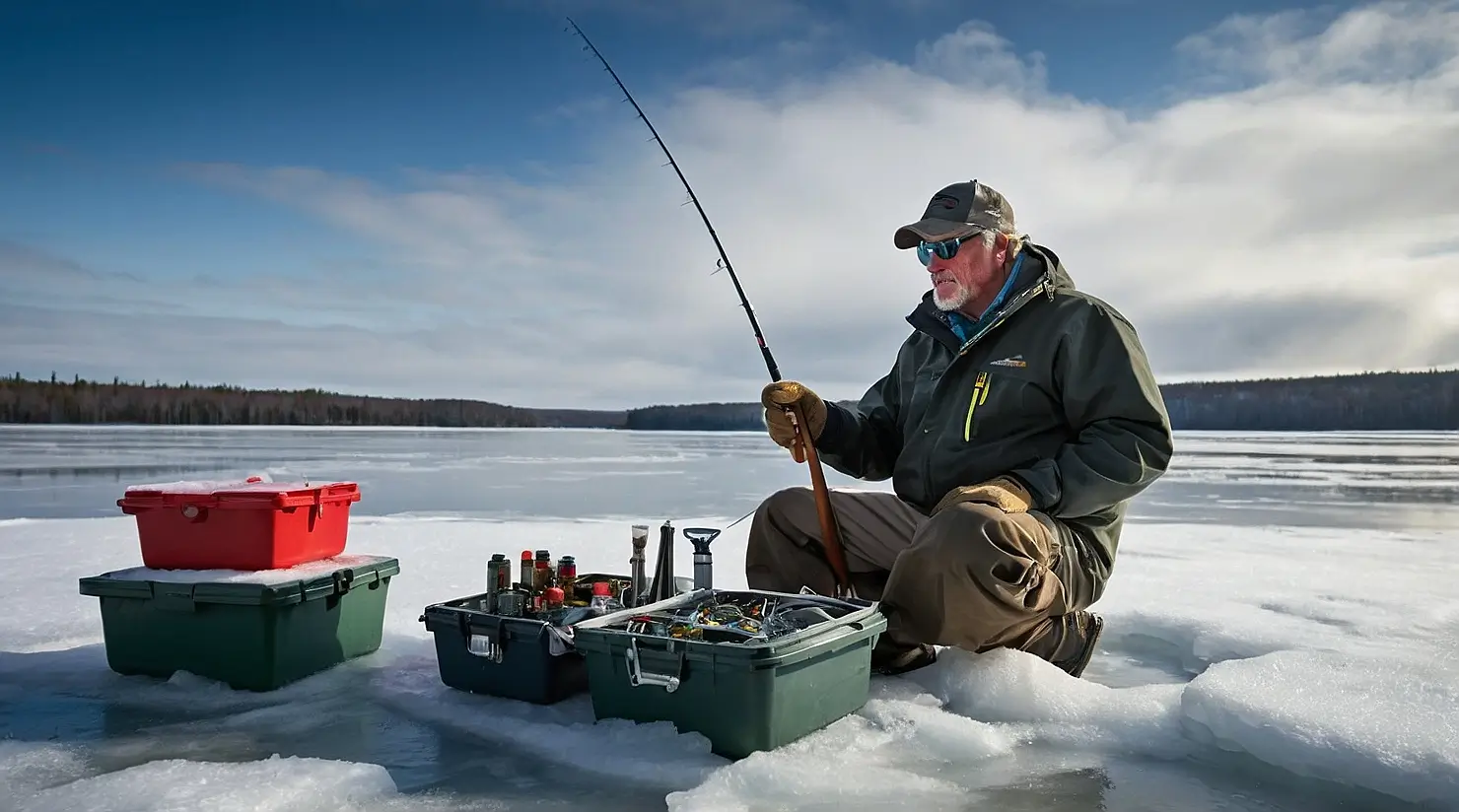Having the right ice fishing gear essentials keeps you safe, warm, and helps you catch more fish on Canada’s frozen waters. This guide covers the basic items you need for a successful trip.
In a Nutshell: Ice Fishing Gear Essentials
- You will learn the key safety items needed for ice fishing.
- You will understand the basic clothing and shelter options.
- You will know the essential fishing tools like rods, lines, and augers.
- You will find tips for choosing gear, especially for popular fish like pike.
Estimated reading time: 6 minutes
Feeling the bite through the ice is exciting! But being prepared is key. Knowing your ice fishing gear essentials makes your winter fishing trips in Canada much safer and more fun. Let’s look at what you really need.
Safety First: Must-Have Items
Ice fishing involves cold and ice. Safety gear is not optional. It can save your life.

- Ice Picks/Spikes: Wear these around your neck. If you fall through the ice, you can use them to pull yourself out. Look for bright, strong ones.
- Floating Safety Suit: This special suit helps you float. It also keeps you warm if you fall in the water. This helps prevent hypothermia.
- Throw Rope: Keep a rope handy. You can throw it to help someone else or use it if someone needs to rescue you.
- Whistle: A whistle helps call for help if you are in trouble.
- Ice Cleats: These attach to your boots. They stop you from slipping on smooth ice.
- Buddy System: Never go alone if possible. If you must, tell someone where you are going and when you expect to be back. Carry a phone or communication device.
Important: Always check the ice thickness. You need at least 4 inches (10 cm) of clear, solid ice just for walking. If you use a fishing tent or shelter, you need 6-8 inches (15-20 cm). Ice conditions can change quickly, so keep checking.
Ice Safety Gear Checklist
Staying Warm: Shelter and Clothing
Being cold ruins an ice fishing trip. Good clothing and shelter make a big difference.
- Ice Fishing Shelters: Portable tents or “shanties” block wind and cold. Some are simple pop-ups. Others are insulated cabins, maybe even with heaters. Newer shelters might use batteries for lights and heat, as noted by Outdoor Canada.
- Layered Clothing: Wear layers. Start with a base layer that wicks away sweat. Add warm middle layers like fleece. Finish with a waterproof and windproof outer jacket and pants (bibs). Good fishing clothing is key.
- Warm Boots: Waterproof, insulated boots are crucial. Your feet get cold fast standing on ice.
- Gloves and Hat: Protect your hands and head. Use warm gloves that still let you handle gear. A warm hat or balaclava keeps heat from escaping.
- Check Weather: Know the forecast. Wind and extreme cold affect safety and comfort.
- Organize Gear: Pack your sled or bucket the night before. Make sure your auger starts (if powered).
- Charge Electronics: Fully charge your phone, fish finder, and electric auger batteries. Cold drains batteries faster.
- Tell Someone: Let a friend or family know where you are going and when you plan to return. Safety first!
Catching Fish: Tackle and Tools
You need special tools for ice fishing. The gear is different from summer fishing.

- Ice Fishing Rods and Reels: Rods are short (usually 24-36 inches). This helps you feel small bites. Reels should work well in the cold. Look into the best fishing reels for Canada.
- Fishing Line: Use line made for cold weather. It stays flexible and strong in freezing temperatures. Consider options from the best fishing lines for Canada.
- Baits and Lures: Small jigs, spoons, or live bait like minnows work well. The lure needs to attract fish looking up from below the ice.
- Tip-Ups: These devices hold your line in a hole. A flag pops up when a fish bites. This lets you fish multiple holes at once.
- Auger: This drills holes in the ice. You can get manual hand augers, electric ones, or gas-powered ones. Electric augers are popular now. They are quieter and cleaner, especially new lithium battery models.
- Fish Finder (Sonar): Electronics help find fish under the ice. They show depth and where fish might be. Portable fishing electronics are very helpful.
Helpful Accessories
A few extra items make ice fishing easier.
- Ice Skimmer: A scoop with holes to clear ice chips and slush from your fishing hole.
- Bucket or Seat: A simple bucket can carry gear and double as a seat.
- Sled: Helps you pull your gear across the snow and ice easily.
- Tackle Box: Keeps your lures, hooks, and line organized. Look for one designed for cold weather. See options for fishing tackle boxes and storage.
Gear for Specific Fish: Northern Pike
Fishing for big fish like Northern Pike? You might need stronger gear. Guides often suggest:
- Heavy-Duty Rods/Reels: Pike fight hard. Use gear that can handle them.
- Steel Leaders: Pike have sharp teeth. A steel leader stops them from cutting your line.
- Large Baits/Lures: Use bigger, flashier lures or large bait fish on tip-ups.
- Scout Locations: Look for areas with weeds or drop-offs where pike hide. This guide to pike ice fishing offers more tips.
Trends in Ice Fishing Gear
Ice fishing gear keeps getting better. Canada’s fishing equipment market is growing, with sales expected over $350 million USD in 2025, according to market data.

Some trends include:
- Better Batteries: Lithium batteries power augers and shelters longer.
- Eco-Friendly Gear: More people want gear made from sustainable materials.
- Smart Electronics: Wireless fish finders and GPS are more common.
- Better Clothing: Lighter, warmer, and more breathable fabrics.
Growth in outdoor activities keeps pushing companies to offer better gear, often at good prices as seen in market reports. North America, including Canada, is a huge market for this gear according to global analysis.
Final Thoughts
Getting the right ice fishing gear essentials makes a huge difference. Focus on safety first, then warmth and comfort. Finally, choose the right tools to help you catch fish. Enjoy your time on the ice in Canada!
Your Questions About Ice Fishing Gear Essentials Answered (Simply)
What is the most important ice fishing gear?
How thick should ice be for ice fishing?
What clothes are best for ice fishing?
Do I need a fish finder for ice fishing?
What kind of rod do I need for ice fishing?
What is an ice auger used for?
What are tip-ups in ice fishing?



